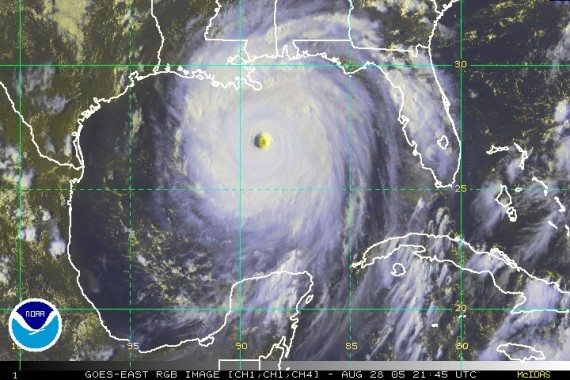
PREPARE A SUPPLY KIT NOW
It’s hurricane season. No one want to hear the words …”has formed in the Gulf of Mexico”, but this is the time to prepare before a storm hits. Forecasters from the National Oceanic and Atmospheric Administration (NOAA) expect an above-normal hurricane season, with up to 21 named storms and as many as 10 hurricanes. The time to prepare is now.
Preparing now will save time and anxiety later. Prepare needed supplies ahead of time for you and your family. Hurricane season ends November 30th
Basic Disaster Supplies Kit
- In case of power loss at ATMs, withdraw cash before the storm.
- Water (one gallon per person per day for at least three days, for drinking and sanitation)
- Food (at least a three-day supply of non-perishable food), ready-to-eat canned meats, canned fruits and canned vegetables, bread, high-energy foods – peanut butter, nuts, trail mix and dried fruits, for example
- Non-electric can opener
- Toilet paper, paper towels, paper cups, plates, plastic utensils
- Battery-powered or hand crank radio and a NOAA Weather Radio with tone alert
- Flashlight
- Extra batteries
- Battery-powered lantern
- Extra fuel for generator and car
- Whistle (to signal for help)
- Dust mask (to help filter contaminated air)
- Plastic sheeting and duct tape (to shelter in place)
- Moist towelettes, garbage bags and plastic ties (for personal sanitation)
- Wrench or pliers (to turn off utilities)
- Cell phone with chargers and a backup battery
- Paper, pens, pencils
- Soap, feminine supplies and other personal hygiene items including denture needs
- Clothing and bedding: a change of clothes, footwear and a sleeping bag or bedroll and pillow for each household member
- Protective clothing, rainwear
- Matches in a waterproof container
- Books, games, puzzles or other activities for children
Important Papers and Identification (store in waterproof container)
- Driver’s license or personal identification
- Social Security card
- Proof of residence (deed or lease)
- Insurance policies
- Birth and marriage certificates
- Stocks, bonds and other negotiable certificates
- Wills, deeds, and copies of recent tax returns
Prescriptions and Non-prescription Medications
- Prescription medications for all family members (at least a 7 to 10-day supply)
- A list of all prescription medications, including dosage amounts and times
- Prescription eyeglasses, contacts, and contact lens solution
- Non-prescription medications – Acetaminophen and ibuprofen pain relievers, antacid, antidiarrheal medication, laxatives
First Aid Kit
- Band-Aids (assorted sizes)
- Antibiotic ointment
- Hydrocortisone
- Antihistamine for allergic reactions
- Epi-Pen for those with allergies
- Antiseptic wipes
- Disposable cold packs
- Gauze pads (assorted sizes)
- Roller gauze
- Surgical tape to secure gauze
- Elastic bandage (like an Ace bandage)
- Oral thermometer
- Cotton balls and cotton swabs
- Sunscreen
- Insect repellant
Infants
- Formula
- Diapers, wipes, diaper cream
- Bottles
- Powdered milk
- Extra bottled water
- Medications
- Pedialyte
- Thermometer
- Portable Crib
- A wrap, carrier, or stroller
- Extra clothes
Special Needs
- Glasses
- Hearing aids
- Catheters
- Augmentative and alternative communication devices
- Cane
- Wheelchair
- Scooter
- Walker
- Dressing aids
- Oxygen
- Tubing
- Feeding supplies
- Emergency health information and emergency contacts
- Also keep a list of the type and serial numbers of medical devices you need.
Pets
- Identification tag with name, phone number, and medical needs. Have a picture of your pet in case you’re separated.
- A week’s supply of food, water, medications, cat litter
- Food and water bowls
- Pet carrier, leash, or harness
- Bags for pet waste
- Veterinarian contact information
- Ahead of time, find pet-friendly hotels in case of evacuation.
- Locate nearby boarding facilities if you’re evacuating to a shelter where pets aren’t allowed. Bring medical records. Facilities may require proof of up-to-date vaccinations.
- Ask out-of-town family or friends if they’d be willing to care for your pets.
- Treats and toys
ALERT NOTIFICATION APPS
Connect Lafayette
Residents are encouraged to sign up for alerts through Connect Lafayette. This service will share important information and updates from Lafayette Consolidated Government. Alerts include both emergency and non-emergency announcements specific to areas where residents live, such as sandbag information, road closures, construction, public works projects, special events, and more.
Residents who live outside Lafayette Parish, but work in the parish can opt-in to receive alerts as well.
Sign up at lafayettecityparish.bbcportal.com.
NOAA Weather Radar Live
Real-time radar images and severe weather alerts
Way to Geaux App
The app provides drivers with around the clock, real-time traffic notifications and road condition updates. Set your destination and the app will automatically send alerts to your smartphone while traveling on interstates, U.S. and state highways.
Alert FM App
ALERT FM aggregates state and local emergency alerts and messages, including National Weather Service warnings, evacuation information, homeland security notices.
Red Cross Hurricane App
Monitor conditions and find help and let others know you are safe
SANDBAGS LOCATIONS OPEN YEAR ROUND
- North District site at 400 N Dugas Road (located off North University Avenue)
- Picard Park at 130 Park Drive
These locations are self-bagging; bring shovel and manpower.
Bags Per Household
- Please limit sandbags to four bags per exterior door.
- Maximum of 20 sandbags per household.
Please note that sand bag locations within all municipalities will be announced ahead of a storm.
HOW TO STAY UP-TO-DATE DURING STORMS
During storms, stay up-to-date with road closures, curfews, sandbag information, etc. by visiting Lafayette Consolidated Government’s website, www.lafayettela.gov, following Lafayette Consolidated Government’s Facebook page, www.facebook.com/lafayetteconsolidatedgovernment, or by visiting the 311 Lafayette Portal, www.311lafayette.services.
SOURCE: Lafayette Consolidated Government.

